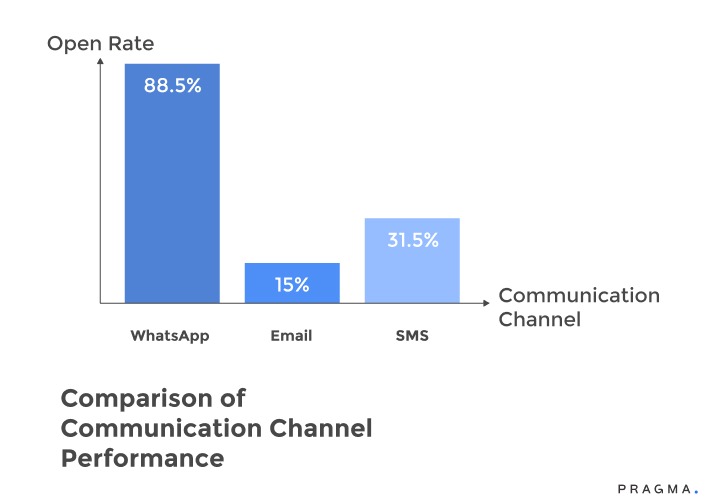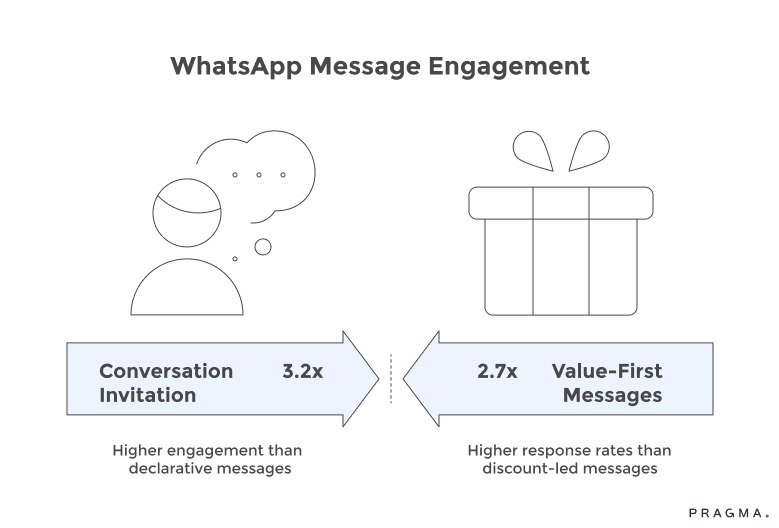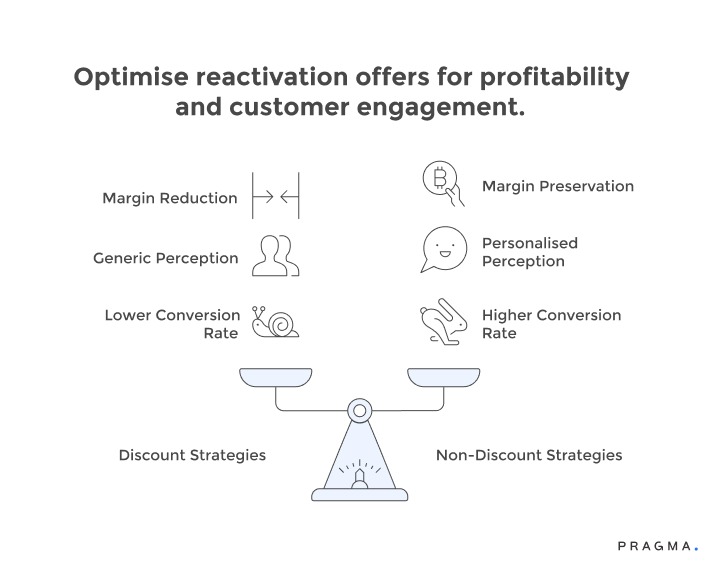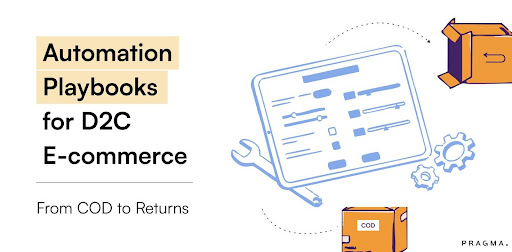In the competitive world of Indian D2C e-commerce, winning a customer once is just the start—keeping them coming back is the real challenge. Yet, for many brands, inactive or “lapsed” customers represent an untapped goldmine:
these are shoppers who have already trusted your store, but for any number of reasons have faded away, stopped opening emails, or haven’t placed a repeat order in months. Ignoring this cohort means lost revenue and higher acquisition costs as marketing budgets keep chasing new buyers.
WhatsApp—India’s most ubiquitous messaging app—offers D2C brands a powerful and personal channel to rekindle interest among dormant customers. Unlike generic retargeting email campaigns, smart WhatsApp flows can deliver targeted nudges, seasonal offers, and rich, interactive content directly to the customer’s phone, cutting through the noise and generating instant engagement.
Automated triggers based on customer activity, personalised recommendations, and frictionless reply options transform re-engagement from just a hope into a measurable business driver.
This blog unpacks on proven strategies for Re-engaging inactive customersThrough Smart WhatsApp Flows. You’ll learn how to segment and target lapsed buyers, design context-aware messaging flows, use AI-powered follow-ups, and measure campaign success in real time.
For D2C brands ready to grow revenue from their existing customer base, smart WhatsApp re-engagement flows aren’t just clever— they’re essential.
Why does WhatsApp outperform email and SMS for customer reactivation?
Platform intimacy creates psychological receptiveness that promotional channels cannot replicate

WhatsApp occupies a fundamentally different mental space than email or SMS in customer perception. People check WhatsApp 23-38 times daily for personal conversations, maintaining constant connectivity that creates availability for brand messages delivered through this intimate channel.
Open rates reveal the dramatic difference—WhatsApp messages achieve 85-92% open rates within 3 hours compared to email's 12-18% open rates over 48 hours and SMS's 28-35% opens over 24 hours. This visibility advantage alone justifies channel prioritisation, but response rates tell the fuller story.
Conversational format enables two-way dialogue rather than one-directional broadcasts that characterise email and SMS. Customers can ask questions, express preferences, or raise concerns within the same thread, creating engagement loops impossible through broadcast channels. This interactivity transforms reactivation from brand push to customer pull, fundamentally altering psychological dynamics.
Rich media capabilities allow product showcasing through images, catalogs, and videos that demonstrate value viscerally rather than relying on text descriptions. Beauty brands sending ingredient comparison videos achieve 3.4x higher click-through rates than equivalent email campaigns, whilst furniture brands using catalog features enable browsing without leaving WhatsApp interface.
Analysis of 80,000+ reactivation attempts across Indian D2C segments shows WhatsApp generates reactivation rates of 22-34% compared to email's 6-11% and SMS's 4-8%. The gap widens further when examining conversion quality—reactivated WhatsApp customers complete purchases at 42% rates versus 23% for email and 18% for SMS, indicating higher intent quality beyond mere response metrics.
What customer segmentation enables targeted WhatsApp reactivation?
Dormancy duration and purchase history determine optimal messaging approaches and offer structures
Effective customer reactivation hinges on tailored strategies, as a one-size-fits-all approach to inactive customers proves inefficient. Sophisticated segmentation is key to maximising response rates by targeting diverse dormant populations with precision.
Foundational Segmentation Methods:
- Recency-based Segmentation: Customers inactive for 3-6 months have different needs than those dormant for 12-18 months. Recent churners may only need simple reminders, while long-dormant customers require more substantive engagement to rebuild trust and re-establish value.
- Purchase History Patterns: Single-purchase customers might have had disappointing initial experiences, requiring different approaches than multi-purchase customers who merely drifted away. High-value customers merit personalised outreach and premium offers, while low-value customers can receive automated flows with modest incentives.
- Category Affinity: Relevant product recommendations, such as skincare new launches for customers who previously purchased skincare, significantly improve engagement compared to generic store-wide promotions.
- Engagement History: To prevent message fatigue, customers who have ignored previous reactivation attempts need fresh approaches or channels. WhatsApp, for instance, can circumvent the "banner blindness" accumulated from overused channels like email.
Case Study: Pune Fashion Brands
Pune fashion brands exemplify sophisticated segmentation by categorising inactive customers into six segments:
- recently churned (3-6 months)
- moderately dormant (6-12 months)
- long dormant (12-24 months)
- Single-purchase
- Multi-purchase
- and high-value (lifetime spending >₹8,000).
Each segment receives tailored WhatsApp flows with appropriate messaging, offer depth, and conversation complexity. This approach has led to a 38% overall reactivation rate, significantly outperforming the 19% achieved through undifferentiated broadcasts.

How should brands structure WhatsApp reactivation flow sequences?
Multi-message journeys outperform single broadcasts through progressive value building and permission maintenance

Single WhatsApp messages achieve limited reactivation success compared to thoughtfully sequenced flows that build engagement progressively. Flow design requires balancing persistence with permission respect, creating multiple touchpoints without triggering blocking behaviour.
Initial value-first messages establish re-engagement without immediate sales pressure. Brands opening with useful content—styling guides, usage tips, or product care advice—generate 2.7x higher response rates than discount-led opening messages. This approach rebuilds relationship foundation before requesting purchase action.
Permission confirmation separates interested customers from permanently churned ones efficiently. Second message asking "Would you like to hear about [specific benefit]?" enables customers to opt in or out explicitly, preventing wasted outreach to uninterested segments whilst concentrating effort on responsive audiences.
Progressive incentive escalation maintains engagement through sequence. Starting with modest offers and increasing discounts with each message creates urgency without immediately deploying a maximum discount that leaves no escalation room. Customers ignoring 15% offers might respond to 25% offers in the third message.
Conversation invitation transforms broadcasts into dialogues. Messages ending with open questions—"What stopped you from ordering again?" or "Which products interest you most?"—generate 3.2x higher engagement than declarative messages, creating two-way exchanges that reveal reactivation obstacles brands can address directly.
Response-based branching personalises journeys based on customer signals. Customers expressing price sensitivity receive discount-focused paths, whilst those mentioning product variety get new arrival showcases. This dynamic adaptation improves relevance exponentially compared to linear sequences.
Why does personalisation depth determine WhatsApp reactivation success?
Generic broadcasts fail whilst data-informed customisation creates perceived individual attention
Enhancing Customer Re-engagement Through Personalised WhatsApp Flows
Key Personalisation Strategies:
Leverage Purchase History:
Referencing past purchases, such as asking "How's the [Product Name] you ordered last [Month]?", immediately signals an authentic relationship. This contextualisation transforms the message from a generic broadcast into a relevant touchpoint.
Integrate Browsing Behavior:
Customers who have previously viewed specific categories but haven't purchased are highly receptive to reactivation messages that highlight those exact interests. This demonstrates that the brand pays attention to individual preferences beyond completed transactions.
Customise Based on Demographics and Psychographics:
Tailoring messaging to customer profiles is crucial. For instance, young urban customers might respond better to trend-focused messages and social proof, while older customers in smaller cities may prefer an emphasis on value and practical benefits. Adapting the communication style based on the customer's profile significantly boosts engagement.
Address Specific Obstacles:
Showing a genuine intent to solve problems is highly effective. Customers who abandoned carts due to delivery concerns require logistics reassurance, whereas price-sensitive customers may need discount justifications. Customising value propositions to individual friction points has been shown to generate 3.8 times higher conversion rates compared to generic incentives.
Real-World Example: Jaipur Home Goods Brand
A Jaipur home goods brand successfully implemented deep personalisation in their reactivation flows. They referenced specific rooms customers had furnished previously, such as "Planning to refresh your living room like you did last year?", and recommended complementary items based on past purchases. Furthermore, they adjusted the formality of their messaging based on customer age demographics, using casual language for customers under 30 and a more formal tone for those over 45. This granular customisation resulted in a 41% reactivation rate, significantly outperforming template-based approaches which achieved only 22%.
What strategies maximise WhatsApp reactivation economics?
Incentive calibration balances reactivation probability against margin preservation

Reactivation offers represent investment decisions requiring optimisation between conversion probability and transaction profitability. Excessive discounts reactivate customers at unprofitable margins, whilst insufficient incentives fail to overcome inertia preventing repurchase.
Tiered incentive structures align discount depth with customer value potential. High-lifetime-value customers receive 15-20% discounts that maintain healthy margins given their expected repeat behaviour, whilst one-time purchasers warrant 30-40% discounts since reactivation itself proves uncertain and requires stronger motivation.
Minimum order thresholds protect margins by ensuring discounts apply to meaningful transaction sizes. Offering 25% off orders above ₹1,500 prevents discount application to small purchases that generate minimal contribution after logistics costs, concentrating reactivation investment on economically viable transactions.
Non-discount value additions preserve perceived generosity without margin sacrifice. Free shipping, complimentary samples, or gift-with-purchase create incentive perception costing ₹60-120 rather than percentage-based discounts reducing margins significantly. These alternatives prove particularly effective for already-discounted product categories.
Time-limited urgency drives immediate action rather than indefinite consideration. Offers expiring in 48-72 hours generate 2.4x higher conversion than open-ended offers, creating forcing function that overcomes procrastination whilst maintaining scarcity perception that enhances value.
Category-specific offers outperform store-wide discounts by demonstrating relevance. Customers who previously purchased skincare respond better to "25% off all skincare" than generic "25% off everything," perceiving targeted offers as personally relevant rather than mass promotions.
To Wrap It Up
WhatsApp reactivation transforms dormant customer databases from sunk acquisition costs into renewable revenue streams through conversational engagement that rebuilds relationships rather than broadcasting promotional desperation. The channel's intimacy demands sophistication—success requires segmentation discipline, flow design thoughtfulness, personalisation depth, and permission respect that generic email blasts never developed. Brands treating WhatsApp reactivation as an evolved broadcast medium fail, whilst those embracing conversational dynamics achieve 28-42% reactivation rates that fundamentally alter customer acquisition economics.
This week, segment your inactive customer database into high-value, engaged-but-churned, and single-purchase tiers, then design a value-first WhatsApp flow for your top 300-500 dormant customers that opens with useful content rather than discounts to establish reactivation conversation without immediate sales pressure.
Long-term reactivation excellence requires systematic flow optimisation based on response pattern analysis and conversion tracking that reveals which messages, offers, and conversation approaches generate profitable customer returns.
Brands should establish quarterly reactivation campaigns targeting different dormancy cohorts with continuously refined messaging informed by previous performance data, building institutional knowledge about customer churn reasons and effective reactivation mechanics.
The competitive advantage compounds as reactivation capability reduces acquisition dependency, improves cash flow through latent database monetisation, and creates sustainable growth models that don't require perpetual new customer acquisition to maintain revenue targets.
For D2C brands seeking to transform dormant databases into active revenue contributors, Pragma's customer engagement platform provides intelligent WhatsApp automation, behaviour-based segmentation systems, and conversation analytics that help brands achieve 28-38% reactivation rates whilst reducing reactivation costs by 40-55% through optimised message sequencing, automated response handling, and predictive customer scoring that identifies highest-probability reactivation targets for focused campaign investment.

FAQs (Frequently Asked Questions On Re-engaging Inactive Customers Through Smart WhatsApp Flows)
1. Can brands message customers on WhatsApp without explicit WhatsApp opt-in if they have general marketing consent?
No—WhatsApp requires channel-specific consent separate from general marketing permissions due to platform intimacy and Meta's policy enforcement. Brands must secure explicit WhatsApp opt-in through website checkboxes, order confirmations, or post-purchase enrollment campaigns.
Violating this requirement risks account suspension and permanent customer blocking that destroys reactivation infrastructure. Email/SMS consent doesn't transfer to WhatsApp automatically.
2. What prevents customers from immediately unsubscribing when receiving reactivation messages?
Leading with value rather than promotional requests reduces unsubscribe likelihood dramatically. Messages offering useful content, requesting feedback, or acknowledging absence before pitching sales maintain 94-97% retention through sequences, whilst discount-first approaches trigger 8-15% unsubscribes in first message.
Respecting previous purchase context and keeping frequency reasonable—4 messages over 17 days maximum—preserves permission whilst creating reactivation opportunities.
3. How should brands handle customers who respond negatively to reactivation attempts?
Immediate human escalation with empowered resolution authority proves essential. Customers expressing frustration about previous experiences need sincere apologies, specific issue resolution, and meaningful compensation (₹300-600 credits) beyond standard offers.
Document negative feedback systematically to identify product, delivery, or service patterns requiring operational fixes. Roughly 60-70% of appropriately handled complaints convert to successful reactivations when resolution demonstrates authentic care beyond transactional relationships.
What reactivation offers depth makes economic sense for different customer value segments?
High-value customers (LTV >₹5,000) justify 15-20% discounts maintaining healthy margins given repeat purchase probability, whilst single-purchase customers warrant 30-40% discounts as reactivation itself proves uncertain.
Never exceed 40% discounts even for long-dormant customers as margin erosion prevents ROI achievement—customers requiring steeper incentives likely won't generate profitable lifetime relationships. Consider non-discount value like free shipping or gifts that cost ₹60-150 rather than percentage reductions.
Talk to our experts for a customised solution that can maximise your sales funnel
Book a demo


.png)

.png)